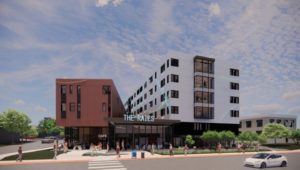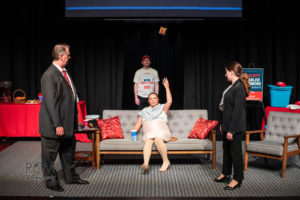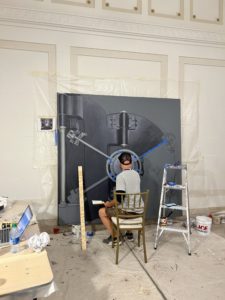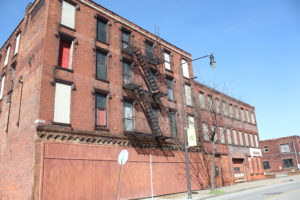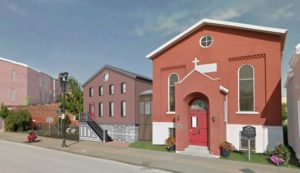Artist’s new studio space & gallery will open to the public next month
There’s nothing I like more than talking about Buffalo. Seriously, it is my favorite conversation starter when I am visiting a new city or making someone’s acquaintance. So when I had the opportunity to sit down with Mark DiVincenzo and pick his brain about the Buffalo art scene – and an exciting personal and professional endeavor he is embarking upon – it was a no-brainer.
I met Mark the same way I have met everyone I know in this great town: through someone else. Everyone in Buffalo is somehow connected, and usually, it isn’t even six degrees of separation but rather a friend of a friend linking us all together. As I often say, this city is a small living room and you’d better be careful before you start dating someone new or moving to a new part of town because you might be related to them [laughing, kind of].
Mark is married to my Pilates instructor Sarah Griffin DiVincenzo and together they had a shared studio space in Buffalo’s Five Points neighborhood called Pilates Art Studio. Sarah’s studio is right above Remedy House, and you can find me there at least once a week before work doing a reformer class with her. One of Mark’s studio spaces was on the third floor of the building, and he had another on Niagara Street.
Not too long ago, he decided to look at a studio space in Snyder and consolidate/rent out the places in the city. I met Mark at the new studio and sat down with him there to talk about his life in the Buffalo and New York City/California art scene, the important commercial work he has undertaken around town, and his plans for a gallery and studio opening sometime in October. I also chatted with him about what inspires him and what art in Buffalo and beyond means to him and how it enriches his life and expands his world.
Mark and Sarah, with their son Gianluca
You are a Buffalo native and take great pride in that, but have lived and traveled all over the world practicing your art. Tell me a bit about how you got started.
I grew up in Buffalo and started drawing and sculpting at age four. I lived two doors down from Jackie Felix and that was the beginning of my art career. I walked to her house and I was in awe of Jackie’s studio. She became a big influence on me and got me interested in art and the creative process from very early on.
From there, I began to take art classes and went to a great grammar school called School 81 known for its art program, industrial arts, and music. The emphasis used to be a lot more prevalent on music and the arts growing up, and now it seems that more and more schools are cutting important programs such as these. I was very lucky to experience a great education here in Buffalo fully immersed in the arts. From there, I went to Buffalo State College and was fortunate to study abroad in Sienna, Italy.
Travel inspires me and my art, and I still find inspiration wherever I travel to. Throughout my study abroad time in Sienna, I traveled around Europe. Looking back, that changed my life completely because I was totally immersed in art. It propelled me when I got back to the States to delve right in.
After graduating college, you lived in New York City and California. What was the art scene like in those cities when you lived there, and what inspired your art during that time in your life?
I was lucky enough to live in New York City after school and show my work at art studios in Chelsea neighborhood of Manhattan. That really changed me: learning from gallery owners and curators in the City inspired me to create. The amount of work that was necessary to be successful in New York City was nothing less than daunting but it taught me a lot.
California also provided me with inspiration but in a different way as the two places are so different. I went to San Francisco and Santa Monica, and lived there for about five years. When I came back to Buffalo as a fine artist I met another local talent that introduced me to the interior world. I burned the midnight oil with painting at night, which was when I was most inspired and the only time of day that would allow for spare moments to create those pieces.
Mark, Sarah, and Gianluca
You have a new studio space in Snyder, NY. What made you look outside the city?
The reason for the new studio was simple: family came first and that is the reality. I was going to figure it out and wanted to do something when my other leases were up. This, as is often the case with my artwork as well, it was a rhythmical decision that we made together as a family. I wanted to be close to my son’s school and our new home in Snyder. I love the energy here and everyone has been very welcoming. My hope was to find inspiration in our new hamlet and propel that energy and love into the new studio space here.
What do you have in mind for this space? What will be different about it, and what do you see for your future here?
This is a new venture and I want it to be similar in some ways to my old spaces but with a new breath of life in it and trying new things here. Classes may happen at the new studio space: I would like to teach different things like art restoration and architectural art which are necessary skills to restore churches, etc. and so many of the old buildings around Buffalo. If I teach these classes here, I want to make sure they are all geared toward the professional world, to teach specific skills to local artists. Skills and classes that I would have been interested in learning.
The new studio will also showcase some of my work. My hope is to have it prepared and ready to go for our gallery/studio opening next month. I hope it provides inspiration to those that come, and to me too – to continue to create new projects.
A lot of your fine art is oil on canvas but the pieces are fairly large. Why is it important to create art on such a big scale, and what do you hope the person viewing that art gets out of it when they see it?
It started when I created pieces at the Tri-Main Studio space on Main Street. I created a great deal of work there and it was such a big studio space, it was a natural progression to want to make larger pieces. The bigger the studio is, the bigger you want to work.
Your art is varied, but you do a great deal of large-scale oil on canvas that highlights nature and specific pops of color. Can you embellish a little on that?
All of this nature work comes from my past: I have been a city guy my whole life. I grew up in the City of Buffalo and lived here and in places like NYC as an adult. In a way, it is an escape from my everyday life in the city.
I am a true outdoorsman and have done serious hiking throughout my life. My family and I love the water and being outdoors together. When I take walks out in nature it is a complete juxtaposition of my daily grind and life. Perfect natural rhythm is in nature and I respond to that. I hope the peace and tranquility I find in nature by myself or with my family reflects in my art.
The colors I choose are muted tones, which all create different movements from the color palette for that specific piece. Some nature scenes are brighter and some use dark tones to compel the feeling I want to convey. It is all about my mood and where I am at with my life. I love the looseness of the paintings compared to tight paintings There is a place for paintings–loose paintings give you movement and a whole new layer of colors. Everyone can find something different in each one of my works, and that is a wonderful part of it for me.
Can you talk a little bit about ‘Painting 101’ for those that might not be well versed on what tools you use as an artist to create?
I use oil on canvas. The canvas I use is a very heavyweight canvas. It is on stretcher bars. The pallette I use is very important as it creates a mood. My earlier work is much more escapism. I am definitely attracted to patterns, and wind. I like how movement happens and the beautiful formations that happen in nature which I bring to each oil on canvas piece I create.
With the big pieces, the entire canvas is energized, when it is that happens your mind goes somewhere differently. I dig what happens when I am inspired and what pulls me in. My hope is to pull people in too.
Besides all of the fine art that you produce, you have a real eye and passion for commercial/interior work which is a completely different endeavor for an artist. Can you tell me a little bit about your history with that?
To afford my passion as an artist, I ‘fell’ into the interior world that was much more sustaining income-wise. I actually started my interior architectural art in 1983. I worked in hundreds of homes and restaurants doing hand-painted wall finishes, design, faux finishes, and murals. During this time I amassed a large body of gouache study paintings working rights. These studies became large oil paintings that propelled me into the NY Chelsea Art scene. As a result, I took a hiatus from the residential/commercial world around 2001 for about 10 years while I was maintaining a studio in NY, specifically Bushwick during my stint with Sears/Peyton gallery.
In 2011, I re-entered the architectural art world for important reasons. My first job was the restoration of the Hotel Lafayette, working with the Historic Commission, to recreate burl wood panels, marble panels, and gold gilding throughout various areas. Since then I have worked on numerous historic restoration jobs that include notably Our Lady of Victory, Blessed Trinity, The Gold Dome, The Statler, and The Main Building that I am presently working at and hugely proud of. Another project that I am about to be part of is with SACRA, led by my friend and UB Architect professor Dennis Maher (Assembly House and SACRA). We will be doing a workshop, with his students creating a very cool wall installation influenced by Charles Burchfield at the Burchfield-Penney Art Center.
You grew up in Buffalo and have made a great life here creating beautiful art and restoring architectural gems around the City and beyond. What do you love about the Buffalo art scene, and living here?
Local Artists such as Peter Stephens, because he started young and he was painting and drawing when I was. Philip Burke also comes to mind. I have always just followed his career and his work inspires me. For galleries in town, Burchfield and Albright Knox are wonderful. Burchfield Penney Art Center really supports the local art scene and it is great for its community, and I have shown there. The one gallery I like Rivalry Projects is beautiful and they just started introducing painters. It is fun to go there and see what’s showing and get to know the painter behind the works on the wall.
As for this studio or anywhere I have been in the past: I look at these bare walls and I look at all the work ahead of me. It inspires me to create. I literally start to measure it out and see what I want to paint next. It is great motivation for me. Buffalo also shows me a lot of beauty, whether I am out with my family in nature or at a beach or on my own exploring new galleries and openings. I am excited for what’s next.
The new studio space is on Kensington Avenue in Snyder, NY. Please visit his website for details about the opening in October, or contact Mark to purchase a piece of his artwork.
The post Small Business Spotlight: Artist Mark DiVincenzo finds his “Perfect Natural Rhythm” appeared first on Buffalo Rising.

